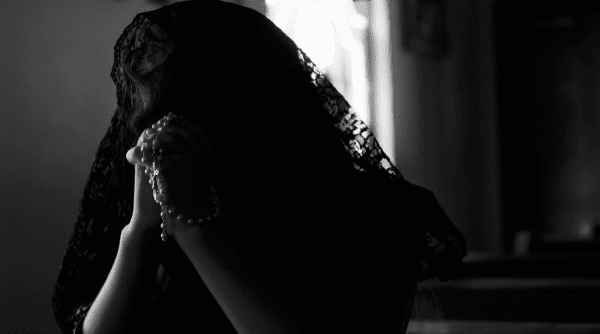St. Rita of Cascia
It was the year 1450, and it the first Holy Year declared in the Church. Lay and religious pilgrims joyfully converged upon Rome – including a band of Augustinian nuns from Cascia, in the region of Umbria in central Italy known for its saints, as the birthplace of St. Benedict and St. Francis.
Among them was an elderly nun, weak and exhausted from the long journey, but rejoicing to be the great Holy City.
Little did Rita of Cascia know that 550 years later, during another Jubilee year, she would return to Rome – or, her mortal remains would – by a police helicopter, to be venerated by pilgrims and the Pope himself, in honor of the 100th anniversary of her own canonization.
Pope John Paul II reminded the crowd gathered there Saturday, May 20, 2000, that she was the first woman to be canonized in the Great Jubilee year of 1900. She was, he said, “small in stature but great in holiness, who lived in humility and is now known throughout the world for her heroic Christian life as a wife, mother, widow and nun. Deeply rooted in the love of Christ, Rita found in her faith unshakeable strength to be a woman of peace in every situation.”
His voice, trembling with age and suffering, spoke of one of his famous themes. “Rita well interpreted the ‘feminine genius’,” the Pope said, “by living it intensely in both physical and spiritual motherhood.”
And so she did.
It had been a long journey, her pilgrimage, not just physically, but in spirit as well. Rita’s life was a series of sufferings, of twists and turns, of losing everything and finding it again.
Born Margherita Lotti in 1381 to aged parents who rejoiced to finally have a child after years of infertility, Rita grew up in a devout home. Anxious to have her future secured as they neared old age, her parents arranged for a marriage when she was a very young teenager.
Her husband, Paolo Mancini, was an angry man at first, embroiled in the feuds common between Italian families at the time. Rita’s goodness and prayers softened him. Still, he became of victim of the violence and was murdered in a blood feud, leaving her a young widow with two sons.
Adding to her grief, Rita’s anguished sons swore revenge for their father’s death. Her pleas for forgiveness for the killers went unheard. So she turned to the God who always hears, and begged Him to spare her sons from the stain of mortal sin. Shortly after, they both died, probably of the plague, and Rita was utterly alone.
She longed to enter the Augustinian monastery of St. Mary Magdalen but faced a serious obstacle: one of the medieval requirements for admission was that a childless widow have her relatives’ permission to enter. Her husband’s family would have withheld their permission unless she joined the bitter vendetta. Rita turned again to prayer, and received the grace, miraculously, to forge a peace between the two families.
She became a nun, devoted the last half of her life to intense prayer, and received the stigmata on her forehead in the form of a wound from the crown of thorns. It caused her unspeakable pain and would have prevented her from making the pilgrimage to Rome during that first Holy Year. When it was time for the nuns to leave, though, the wound disappeared. Rita set out with them, making the difficult journey with joy.
She would live just a few more years before her final pilgrimage to heaven in 1457. The day of her death is her feast day: May 22.
Who knew, at the time, that this simple woman of the Beatitudes – a woman of peace and meekness, who mourned but showed mercy – would hundreds of years later be invoked by millions as patroness of impossible causes? Who knew then that one of the greatest popes, a Saint himself, would esteem her as a model of the feminine genius and both kinds of motherhood, physical and spiritual?
St. Rita reminds us that our Church is rich in men and women who show us what is best about ourselves, whose qualities of holiness transcend time and place. Even now she makes little pilgrimages into our own situations of sufferings in our homes, she journeys with us in our pleas for seemingly impossible resolutions in our marriages and families, and she joins us in our daily prayers to become people of forgiveness and mercy.
St. Rita, pray for us!




